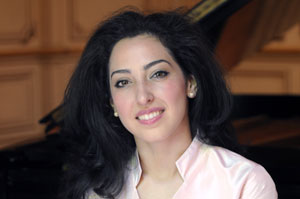The Washington Post
Pianist Sara Daneshpour stuns at the American Art Museum
سارادانشپور پيانيست برجسته و جوان ايراني با اجرای خود در موزه هنر آمريكا- واشنگتن تحسين همگان را بر انگیخت
سارادانشپور پيانيست برجسته و جوان ايراني قطعات متنوع موسيقي كلاسيك از سبکهای رمانتیسیزم گراندوس تاامپرسیونیزم راول واکسپرسیونیزم پروکوف را با مهارت تحسین برانگیزی در موزه هنر آمريكا واشنگتن به اجرا در آورد..
Sara Daneshpour. (Stephanie Lane)
By Stephen Brookes July 14 at 12:06 PM
There may be few more fascinating periods in music than the turn of the 20th century, when romanticism began giving way to impressionism, expressionism and all the other “isms” of the modern world. The fine young pianist Sara Daneshpour made that period the focus of a colorful and beautifully conceived concert at the American Art Museum on Sunday afternoon, tying the romantic lyricism of Granados and Franck to the tone-painting of Ravel and the raw explosiveness of Prokofiev — and playing it all with stunning virtuosity and verve.
A D.C. native still in her 20s, Daneshpour opened the afternoon quietly with a poised, utterly clear and graceful performance of Haydn’s Sonata in F Hob. XVI:16 — a delight to the ears, like virtually everything Haydn wrote. But the Haydn was merely a prelude to Maurice Ravel’s still-astonishing suite of tone poems, “Gaspard de la nuit.”
Written in 1908, it’s a masterpiece of early expressionism, from the shimmering water effects of “Ondine” to the tolling bells and morbid brooding of “Le gibet” (“The Scaffold”) and the taut, menacing “Scarbo” — not only one of the most colorful works in the piano literature (its range of sonorities is astounding), but also one of the most difficult to play. Daneshpour brought it off flawlessly, with both the virtuosic touch she had shown in the Haydn and a rich, imaginative sense of color and dramatic pace.
Sergei Prokofiev wrote his Toccata Op. 11 just a few years after Gaspard appeared, but it’s a much different work that builds driving, repeated notes into an unstoppable powerhouse. Daneshpour turned in one of the strongest and most purposeful readings you could hope to hear, throwing herself into the work for a bravura performance. But she showed a different side of herself in the more introspective “El Amor y la Muerta: Balada” (The Ballad of Love and Death”) by Enrique Granados, the fifth in his “Goyescas” piano suite of 1911. Deeply lyrical, suffused with sorrow and longing, it’s a work whose loose, unpredictable phrasing gives it an almost improvisational feel, and Daneshpour gave it a straight-from-the-heart reading.
Two earlier works — Alexander Scriabin’s “Sonata-Fantasy No. 2” from 1898, and Cesar Franck’s much-loved “Prelude, Chorale and Fugue” from 1884 — closed the program and linked it to late-19th century romanticism. The two-movement Scriabin sonata — a sort of tone poem evoking the ocean — is as impressionistic as it is romantic, and Daneshpour played it with extraordinary sensitivity and a subtle sense of color. Franck’s Bach-influenced “Prelude, Chorale and Fugue” is a masterpiece if there ever was one: intellectually weighty, emotionally complex, and containing an almost monumental sense of power. Daneshpour gave it superb reading, and when called back for an encore, she played a sonata by Domenico Scarlatti with all the deft precision and clarity she had brought to the Haydn.
Brookes is a freelance writer.

